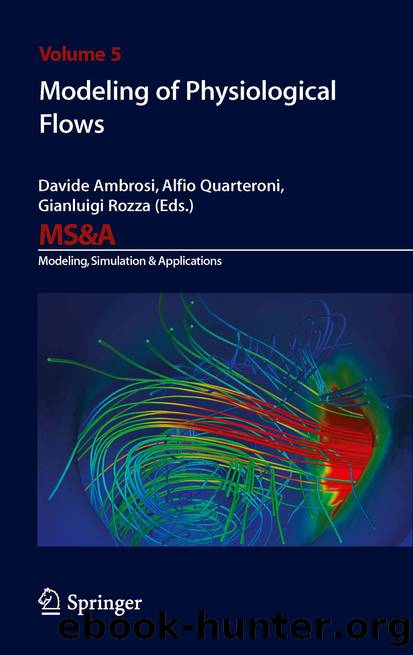Modeling of Physiological Flows by Davide Ambrosi Alfio Quarteroni & Gianluigi Rozza

Author:Davide Ambrosi, Alfio Quarteroni & Gianluigi Rozza
Language: eng
Format: epub
Publisher: Springer Milan, Milano
2 Infrastructure for the VPH-Physiome Project
The VPH-Physiome Project aims to provide a systematic framework for understanding physiological processes in the human body in terms of anatomical structure and biophysical mechanisms at multiple length and time scales. The importance of establishing a solid foundation for the VPH by creating model and data standards, together with mechanisms for achieving model reproducibility and reuse, was recognized in the STEP Roadmap. The framework includes modelling languages for encoding systems of differential-algebraic equations (DAEs, using for example, CellML 6 6 and SBML 7 7) and the spatially varying fields used with systems of partial differential equations (PDEs using FieldML 8 8). In both cases the parameters and variables in the mathematical models are annotated with metadata that provides the biological or biophysical meaning. The languages encourage modularization and have import mechanisms for creating complex models from modular components. Model repositories have been established, together with freely available Open Source software tools to create, visualize and execute the models. The CellML model repository 9 9, for example (discussed below), now includes models for a wide variety of subcellular processes.
Many models of biological processes at the subcellular level ignore the detailed 3D structure of the cell and model the cell excitability, mechanics, calcium (or other second messenger) transients, motility, signalling, metabolism or gene regulation, etc, in a âlumped parameterâ system of DAEs. These models generally either include explicit discretisation of spatial variation, or make the approximating assumption that the model will remain spatially homogeneous (the well-stirred reactor assumption). Sometimes the models also include non-linear algebraic equations or need to solve constrained optimisation problems as part of the solution strategy, but they do not require the solution of PDEs. In some cases the models are âsystems physiologyâ models at the whole body level, but again without the need for solving PDEs. The markup language CellML (www.cellml.org) has been developed to provide an unambiguous definition of these lumped parameter models. The language is designed to support the definition and sharing of models of biological processes by including information about: model structure (how the parts of a model are organizationally related to one another); mathematics (equations describing the underlying biological processes); and metadata (additional information about the model that allows scientists to search for specific models or model components in a database or other repository, and which indicates the biological meaning associated with a model and its parts, allowing the model to be manipulated or interpreted correctly).
The development of a biophysically based mathematical model is, at present, a creative endeavor, often requiring a great deal of insight into the physical processes being modelled and personal judgment about the approximations needed. Once created, however, a model should stand independent of its creator and be reproducible and testable by others. The model and data files, that together can demonstrate reproducibility of a model on an automated basis, are called the reference description of the model. This includes protocols for running the model with appropriate parameter sets and comparing simulation results against suitably encoded experimental data (possibly multiple times to generate typical phenotypic outputs).
Download
This site does not store any files on its server. We only index and link to content provided by other sites. Please contact the content providers to delete copyright contents if any and email us, we'll remove relevant links or contents immediately.
| Automotive | Engineering |
| Transportation |
Whiskies Galore by Ian Buxton(41716)
Introduction to Aircraft Design (Cambridge Aerospace Series) by John P. Fielding(33014)
Small Unmanned Fixed-wing Aircraft Design by Andrew J. Keane Andras Sobester James P. Scanlan & András Sóbester & James P. Scanlan(32682)
Craft Beer for the Homebrewer by Michael Agnew(18079)
Turbulence by E. J. Noyes(7891)
The Complete Stick Figure Physics Tutorials by Allen Sarah(7261)
Kaplan MCAT General Chemistry Review by Kaplan(6818)
The Thirst by Nesbo Jo(6751)
Bad Blood by John Carreyrou(6472)
Modelling of Convective Heat and Mass Transfer in Rotating Flows by Igor V. Shevchuk(6352)
Learning SQL by Alan Beaulieu(6156)
Weapons of Math Destruction by Cathy O'Neil(6080)
Man-made Catastrophes and Risk Information Concealment by Dmitry Chernov & Didier Sornette(5874)
Digital Minimalism by Cal Newport;(5582)
Life 3.0: Being Human in the Age of Artificial Intelligence by Tegmark Max(5402)
iGen by Jean M. Twenge(5320)
Secrets of Antigravity Propulsion: Tesla, UFOs, and Classified Aerospace Technology by Ph.D. Paul A. Laviolette(5234)
Design of Trajectory Optimization Approach for Space Maneuver Vehicle Skip Entry Problems by Runqi Chai & Al Savvaris & Antonios Tsourdos & Senchun Chai(4953)
Electronic Devices & Circuits by Jacob Millman & Christos C. Halkias(4861)
